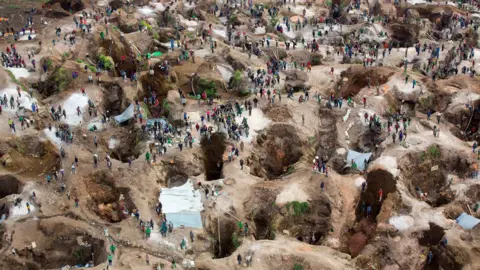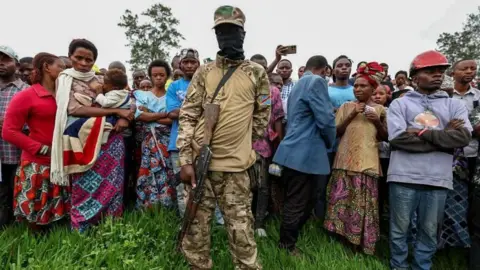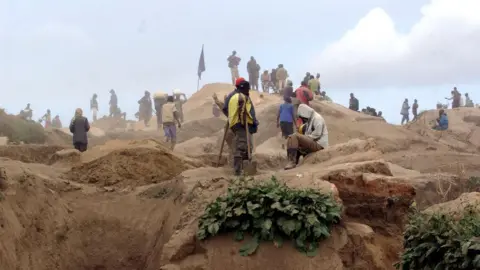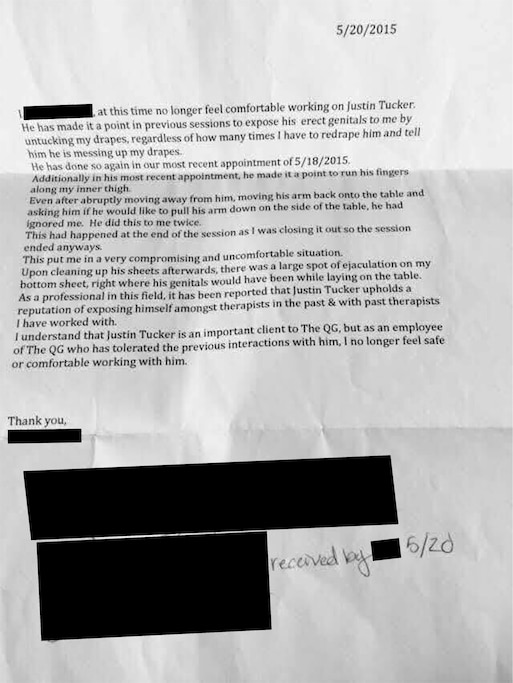 Getty images
Getty imagesThere is a good chance that inside your mobile phone is a tiny quantity of a metal which began its buried journey in the land of the Eastern Democratic Republic of Congo, where a war is currently raging.
It can even be directly linked to the M23 rebellious group which made the headlines this week this week.
The tantalum in your device weighs less than half of the middle garden pea, but is essential for the effective operation of a smartphone and almost all other sophisticated electronic devices.
The unique properties of this rare blue -gray metal – including being able to maintain a high load compared to its size, while operating in a range of temperatures – make it an ideal material for tiny capacitors, which temporarily store the energy.
It is also exploited in Rwanda, Brazil and Nigeria, but at least 40% – and perhaps more – from the world supply of the element comes from Dr Congo and some of the key areas are now under the control of the M23.
The current fighting wave has been held for months, but the Rebels have drawn attention with Sunday’s assault against the Goma trading and transport center. The city, bordering Rwanda, is a regional center for the mining company
During the last year, the M23 has made rapid advances through the east rich in minerals from Dr Congo, taking areas where the Coltan – the ore from which the tantalum is extracted – is extracted.
Like dozens of other armed groups operating in the region, the M23 began as an outfit defending the rights of an ethnic group perceived as threatened. But as its territory has expanded, mining has become a crucial source of income, paying combatants and weapons.
Last April, he seized Rubaya, the city in the heart of the country’s coltan industry.
Mineral extraction in this region is not in the hands of multinational conglomerates – instead, thousands of people work in open wells that in honeycomb the landscape, or underground, in extremely dangerous conditions and unhealthy.
 Monusco
MonuscoThey are part of a complex network, and yet informal, which sees the rocks removed from the ground using shovels, brought back to the surface, crushed, washed, taxed, sold and then exported to be purified and ultimately merged.
Once the M23 has moved to Rubaya, the rebels have established what a group of UN experts described as a “national administration”, issuing permits to diggers and merchants and demanding annual fees $ 25 (£ 20) and $ 250 respectively. The M23 has doubled the wages of the Creusers to ensure that they would continue the work.
He manages the area as a monopoly by ensuring – by the threat of arrest and detention – that only his authorized traders are able to do business.
The M23 also invoices a direct debit of $ 7 on each kilogram of Coltan. The United Nations group of experts estimated that the M23 earns around $ 800,000 per month of Coltan tax in Rubaya. This money is almost certainly used to finance the rebellion.
There is a suspended question mark how the ore extracted from the areas controlled by M23 enters the world supply chain.
Neighboring Rwanda, which is considered to support M23, is at the center of the response, according to the United Nations experts.
Theoretically, a certification program – known as the innovative initiative of the tin supply chain (ITSCI) – should mean that what is happening in a telephone handset and other electronics do not come from zones conflict where it could be used to finance armed groups responsible for the atrocities.
 EPA
EPAUS law Dodd-Frank adopted in 2010 and similar EU legislation aims to guarantee that companies buy tin, tantalum, tungsten and gold-the so-called “conflict minerals” – inadvertently finance violence.
But Itsci was criticized.
Ken Matthysen, an expert in security and resources management of the independent IPI research group, stresses that the dispersed nature of many small -scale mines makes it difficult for local authorities to monitor exactly what is happening everywhere.
The ItSCI labels should be placed on bags with the mine itself, to prove the origin of minerals inside, but often they are transported to a collection point where it becomes more difficult to trace where does it come ore, said Matthysen.
He added that there is also a possible problem with corruption.
“There is even an accusation that state agents sell labels to traders, because they do not win well. The traders then go around Dr. Congo from the East and they label the bags themselves.”
Itsci did not respond to a request for comments from the BBC, but in the past defended his file saying that the program has been subject to a rigorous independent audit. He was also greeted for bringing “prosperity for hundreds of thousands of minors on a small scale”.
In the case of Rubaya, ItSCI suspended its operations there shortly after the M23 in the city.
However, the group managed to continue exporting Coltan.
The United Nations experts map a circuit route showing how it is transported near the Rwandan border. He is then transferred to “heavy trucks” which were to be widened to welcome them.
Rwanda has its own Coltan mines, but experts say that the non -certified pass is mixed with Rwandan production leading to “significant contamination of supply chains”.
The M23 was already involved in the Coltan sector before the capture of Rubaya – creating roadblocks and charging costs to cross them, according to Mr. Matthysen.
“A large part of the trade of these minerals has gone through an area controlled by M23 to Rwanda. So, even then, Rwanda took advantage of instability in eastern Dr. Congo and we saw the export volumes Rwanda was already increasing, “he told BBC.
 AFP
AFPUS Geological Survey figures show that Rwanda Coltanes exports increased by 50% between 2022 and 2023. Matthysen said it could not all come from Rwanda.
In a solid defense of Rwanda’s position, government spokesperson Yolande Makolo reiterated to the BBC that there were minerals and refining capacities in his own country.
“It is very cynical to take a problem as what is happening in eastern DRC, where a persecuted community is fighting for its rights … and transforming) a problem of material profit,” she Added.
Rwandan president Paul Kagame also rejected the reports of UN experts, paying contempt on their “expertise”.
Much of eastern Dr. Congo has been unleashed by conflicts for many years, which raises questions about who has benefited and if armed groups benefit from what is dug there.
In order to highlight the problem and its connection with the smartphones industry, the Congolese government has filed criminal complaints in France and Belgium at the end of last year against the subsidiaries of the Apple technology giant, the Accusing of using “conflict minerals”.
Apple has challenged the allegation and stressed that since the beginning of 2024, due to the climbing of conflicts and certification difficulties, it has stopped supplying Tantalum, among other metals, Dr Congo and Rwanda.
Other companies have not been so clear, which means that the M23 grabs more territory, these small pieces of tantalum of the mines they control could still make their way in the devices on which we have finished.
More stories from the BBC on the conflict in Dr Congo:
 Getty Images / BBC
Getty Images / BBC


